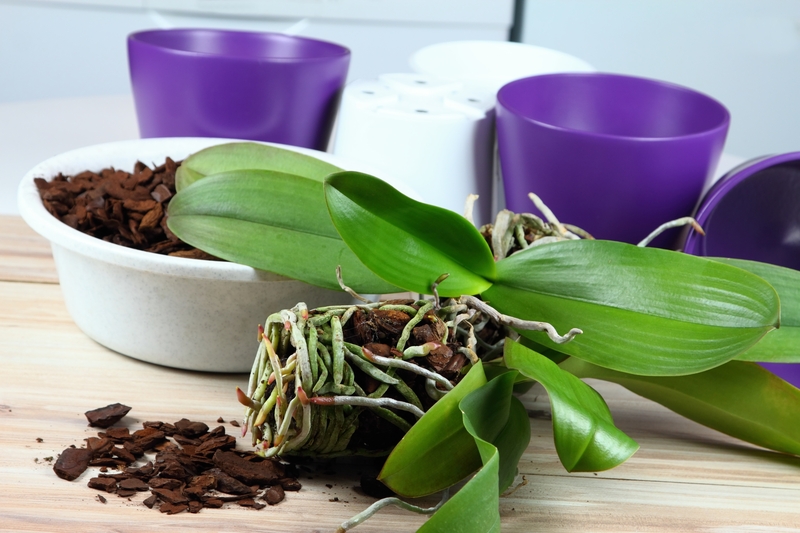Gentle Breezes: Managing Garden Wind Challenges
Posted on 18/08/2025
Gentle Breezes: Managing Garden Wind Challenges
Embracing the natural elements while cultivating a thriving outdoor space is part of the beauty and challenge of gardening. One such element, wind, can be both a blessing--refreshing the garden air and aiding pollination--and a formidable foe, threatening plants, soil, and structures. Knowing how to manage wind in the garden is vital for long-term success.
Understanding the Impact of Wind in Your Garden
Wind is a powerful force that shapes the microclimate of any garden. Its effects range from subtle to severe, depending on duration, speed, and direction. Before discussing solutions for managing garden wind challenges, let's analyze the crucial ways gentle breezes--and sometimes not-so-gentle gusts--affect your green space:
- Dehydration: Wind accelerates water evaporation from soil and foliage, causing plants to dry out faster.
- Mechanical Damage: Persistent wind or strong gusts can break stems, topple young plants, or strip away leaves.
- Reduced Pollination: Very strong winds may disrupt bee and insect activity, affecting fruit and seed set.
- Soil Erosion: Topsoil loss from steady winds can lead to poor plant health and reduced fertility.
- Temperature Fluctuations: Wind can either cool a hot garden or make cold winters harsher by removing warmth.
Understanding these potential issues allows gardeners to adopt a proactive approach in wind management and optimize their garden's health.

Assessing Wind Conditions in Your Landscape
Before implementing solutions, observe and assess your garden's specific wind challenges:
- Identify prevailing wind directions: Where do breezes predominantly enter? Consider local patterns and seasonal changes.
- Note wind speed and consistency: Is the wind usually strong and sustained, or is it gentle and sporadic?
- Look for vulnerable areas: Raised beds, slopes, and open expanses often bear the brunt of wind damage.
- Document signs of impact: Dry soil, bent plants, and exposed roots provide clues to wind patterns.
Mapping wind-prone zones can help you make targeted design and planting choices.
Design Strategies for Managing Garden Wind Challenges
Thoughtful garden layout is the first line of defense against wind-related issues. The right strategy can transform a harsh, windswept garden into a sheltered oasis. Consider the following tried-and-true methods:
1. Create Effective Windbreaks
Windbreaks are barriers that slow, filter, or deflect wind, providing protection for sensitive plants. There are two primary types:
- Living Windbreaks:
- Leverage hedges, rows of trees, or dense shrubs on the windward edge of your property.
- Use species suited for your climate; evergreen trees offer year-round protection.
- Examples: Pines, hollies, junipers, privets, or bamboo.
- Structural Windbreaks:
- Install fences, trellises, or lattices with 30-50% permeability to allow some wind through and reduce turbulence.
- Combine with climbing plants (e.g., clematis, ivy, honeysuckle) for added effectiveness.
- Temporary screens (shade cloth, netting) can protect small or newly planted areas.
2. Plant According to Microclimates
Not all areas in your garden are equally exposed. Position the most wind-sensitive plants in naturally protected spots, such as near buildings or existing hedges. Use hardier species as buffers in outer rows, gradually working toward delicate plants as you move inward.
- Tall or dense vegetation: Place on the windward side to act as a living shield.
- Low-growing, mat-forming plants: Use on slopes or open areas to reduce soil erosion and maintain humidity.
3. Stagger and Layer Plantings
Stagger plant arrangements rather than planting in straight lines; this helps disperse wind intensity. Multi-layered plantings--combining trees, shrubs, and groundcovers--duplicate the effect of a natural woodland and improve overall resilience.
4. Use Raised Beds and Solid Barriers Wisely
Raised beds can dry out faster in strong winds. Use solid but breathable materials for edging and consider positioning raised beds away from wind-exposed boundaries. Add mulch to retain moisture and reduce soil loss.
Best Plant Choices for Windy Gardens
Some plants naturally withstand windy conditions better than others. When managing garden wind conditions, select hardy, flexible species that bend rather than break.
- Grasses: Ornamental varieties like Panicum virgatum (switchgrass) or Miscanthus thrive in breezy settings.
- Coastal Shrubs: Tamarisk, Escallonia, Elaeagnus, and Olearia shrug off salt-laden gusts near the sea.
- Wind-tolerant Trees: Hawthorn, Rowan, Alder, Poplar, and Scots pine provide structure and protection.
- Perennials: Lavender, yarrow, and geranium perform well in exposed locations.
- Groundcovers: Thyme, creeping juniper, and vinca help anchor soil in windy spots.
Pro tip: Avoid fragile, top-heavy plants or those prone to break under pressure, especially for exposed corners of the garden.
Soil and Water Management in Windy Conditions
Gentle breezes may cool the garden, but they can also desiccate soil and challenge plant hydration. Clever soil and water management will help your plants stay healthy and robust, even under constant wind exposure.
1. Mulching for Moisture Retention and Stability
- Spread organic mulch (bark chips, straw, leaf litter) or inorganic mulch (gravel, pebbles) around the base of plants.
- Mulch reduces water evaporation, minimizes soil erosion, and helps regulate soil temperature.
- Replenish mulch as needed, particularly after storms or heavy winds.
2. Watering Techniques for Windy Gardens
- Water deeply and less frequently to encourage plants to grow deeper, more resilient roots.
- Use drip irrigation or soaker hoses which deliver water directly to the root zone, minimizing evaporation loss.
- Water early in the morning or late in the evening to prevent rapid evaporation on windy days.
3. Soil Amendments and Ground Cover
- Incorporate compost and organic matter to improve water retention and soil structure.
- Plant ground-hugging species in between crops or in garden pathways to hold soil in place and reduce windblown dust.
Physical Supports and Garden Structures
Some plants and vegetables require extra assistance when contending with wind. The following structures can offer essential stabilization:
- Stakes and Cages: Use bamboo canes, tomato cages, or wooden stakes to support tall annuals, perennials, and vegetables.
- Netting and Row Covers: Lightweight mesh or row covers can provide a protective shield for seedlings and delicate crops.
- Wind shields for containers: Move potted plants to sheltered spots, or cluster pots together behind low walls or fences for protection.
Seasonal Adjustments and Ongoing Maintenance
Wind patterns often change with the seasons. Stay vigilant and adjust your wind management strategies as needed:
- Spring: Extend windbreaks or erect temporary barriers to shield tender emerging plants.
- Summer: Increase watering frequency and monitor signs of stress during dry, breezy periods.
- Autumn: Prune back wind-damaged limbs and clear debris that could become airborne during storms.
- Winter: Wrap young trees and susceptible shrubs with burlap or frost fleece to prevent desiccation and windburn.
Sustainable Solutions for Wind Management
While quick fixes like plastic screens or synthetic barriers can offer immediate relief, consider more sustainable, nature-based approaches for long-term results:
- Native Plantings: Local species are adapted to regional wind patterns and support biodiversity.
- Permaculture Design: Integrates windbreaks with edible landscapes, wildlife corridors, and rainwater management systems.
- Regenerative Practices: Maintain soil health and landscape diversity to withstand and recover from wind events.
Combining resilient landscaping with smart design not only solves garden wind challenges, but also enhances your whole ecosystem's vitality.
Common Mistakes to Avoid with Wind Management
Even the most attentive gardener can make missteps when trying to mitigate the effects of wind. Here are a few pitfalls to avoid:
- Planting windbreaks too densely: A completely solid barrier can create stronger gusts on the leeward side, increasing damage. Use permeable materials.
- Neglecting root care: Wind stress can loosen roots. Mulch well and routinely check for root exposure after storms.
- Ignoring the garden's microclimates: Broad solutions may miss the unique conditions of each garden corner--be observant and specific.
- Choosing fragile containers or furniture: Select heavy, wind-resistant patio items and secure garden ornaments to prevent breakage or loss.

Celebrating the Benefits of Gentle Breezes
Not all wind is detrimental. Gentle breezes help strengthen plant stems, keep foliage dry and healthy, and disperse pests. The trick to managing wind in the garden is to mitigate destructive gusts while enjoying the positive effects of moving air.
Embracing Wind as a Design Element
- Wind chimes, spinning ornaments, and fluttering banners can enhance your outdoor space and celebrate the movement of air.
- Plant grasses and flowers that sway beautifully, introducing movement and sound into your garden scene.
- Use wind as a practical tool--ventilating greenhouses or aiding in passive cooling for sheds and patios.
With careful planning, you can seamlessly integrate wind management techniques and aesthetic enhancements for a delightful garden experience.
Conclusion: Crafting a Resilient, Wind-Proof Garden Oasis
Managing garden wind challenges requires a thoughtful blend of observation, practical design, and ongoing care. By understanding your garden's microclimate, choosing wind-resistant plants, and investing in smart windbreaks, you can protect your outdoor sanctuary while maintaining its beauty and productivity.
Let gentle breezes invigorate your landscape--not dominate it. With the right strategies, your garden will flourish, regardless of the winds that blow.
Frequently Asked Questions - Managing Garden Wind Challenges
- What is the most effective windbreak for a garden?
A well-planned living windbreak with diverse, wind-tolerant shrubs and trees, mixed with permeable fences or trellises, is ideal. - How can you tell if wind is harming your plants?
Look for leaf scorch, wilting even after watering, broken stems, and exposed roots--these are all signs of wind stress. - Can wind improve plant health?
Yes! Moderate winds strengthen stems and help reduce wet foliage, thus preventing many plant diseases. - How do you protect raised beds from wind?
Use barriers, mulch well, and plant low, spreading species around the edges to reduce soil loss and water evaporation. - Are there any garden features that should be avoided in windy areas?
Lightweight ornaments, umbrellas, or shallow containers may be damaged or lost; secure all loose items and opt for heavy materials.
Remember: A garden that harmonizes with the breeze will stand the test of time, offering beauty, comfort, and a tranquil retreat for you and your plants, whatever the weather may bring.

